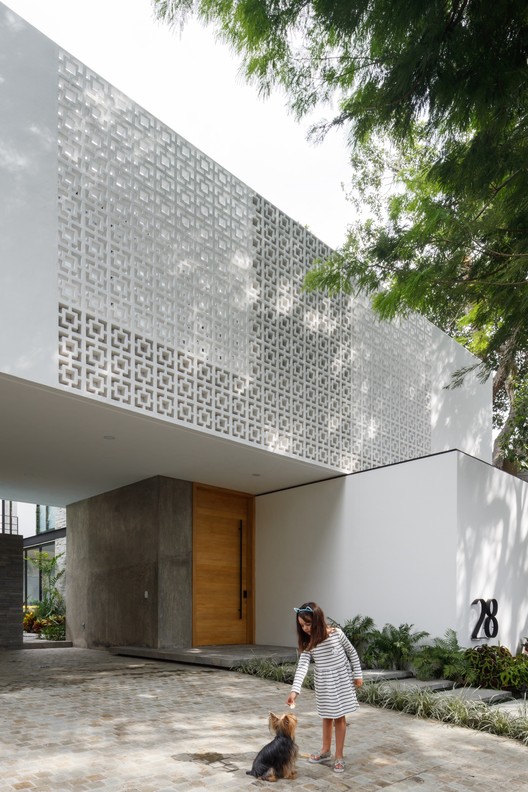AD Classics Wexner Center for the Arts Peter Eisenman
2014-10-17 01:00
韦克斯纳中心位于俄亥俄州立大学校园的东边,是为了容纳一个多学科的空间来探索和展示当代艺术。这个4,300万美元的佣金是1983年艾森曼、迈克尔·格雷夫斯、塞萨尔·佩利、卡尔曼·麦金内尔参加的一场引人注目的比赛的目标。
Located on the eastern edge of The Ohio State University’s campus, the Wexner Center was built to accommodate a multidisciplinary space for the exploration and exhibition of contemporary art. The $43 million commission was the object of a high-profile 1983 competition that featured Eisenman, Michael Graves, Cesar Pelli, Kallmann McKinnell & Wood, and Arthur Erickson as finalists. To the surprise of many, Eisenman won the competition despite his relative inexperience with large-scale buildings, though his selection resulted in no less publicity for the museum. His widely respected name alone carried the museum’s opening, which didn’t even feature artwork so as to not distract from the architecture. [2]
在其概念和过程中,韦克斯纳中心是艾森曼独特的建筑方法的典范。虽然没有完全脱离它的上下文,建筑在很大程度上是一个自我实现和自主的工作,创造了自己独特和独立的方法过程和建筑词汇。博物馆的目的是不为其不正统之处道歉;准历史名言引用了建筑传统,却大胆地拒绝了它。被剥夺功能主义目的正式装置否定空间惯例。一些故意的尴尬和不和谐的时刻使建筑空间与人类占领的交汇点复杂化。对艾森曼来说,这些都是建筑的巨大成功之一,因为它们体现了解构主义解放进入实现形式的话语。
In its concept and process, the Wexner Center is an exemplary illustration of Eisenman’s unique approach to architecture. While not entirely disconnected from its context, the building is for the most part a self-realizing and autonomous work, creating its own unique and self-contained methodological process and architectural vocabulary. The museum purports to make no apologies for its unorthodoxies; quasi-historical quotations reference architectural tradition only to boldly reject it. Formal devices deprived of functionalist purpose disavow spatial convention. And a number of deliberately awkward and discordant moments complicate the intersection of built space with its human occupation. For Eisenman, these are among the great successes of the building, as they manifest the discourse of deconstructivist emancipation into actualized form.
在艾森曼的大部分工作中,强大的网格系统主导着建筑的正式语言。哥伦布市和大学的城市电网之间略有偏离,在项目中重叠。两者之间的12.5度的变化导致博物馆内的轴向旋转,相应的构造元素在这两个系统争夺首要地位时产生了不和谐的交集时刻。艾森曼的拼贴画是为了直观地描述这个项目,展示了相互竞争的网格的张力,并陶醉于一个在实际建筑中发现模仿的间隙歧义中。作为一种营销手段,所有这些都相当于校园与社区的巧妙互动,但作为一种建筑策略,它创造了一种正式的造型,使建筑的各种系统得以形成。
As in much of Eisenman’s work, strong grid systems dominate the formal language of the building. The urban grids of the city of Columbus and of the university, slightly off-kilter from one another, overlap within the project. The 12.5 degrees of variation between two result in an axial rotation within the museum, with corresponding tectonic elements creating jarring moments of intersection as the two systems compete for primacy. The collages Eisenman prepared to visually describe the project illustrate the tension of the competing grids and revel in an interstitial ambiguity that finds imitation in the actual building. As a marketing pitch, all of this amounts to a clever interplay of campus with community, but as an architectural strategy, it creates a formal trope from which the various systems of the building are able to emerge.
贯穿大楼的核心是韦克斯纳中心最明显的特点:一个540英尺长的“脚手架”结构,将平面网格系统挤压成一个三维矩阵。暴露和部分不封闭,这意味着看起来故意不完整,否认作为固定性质的建筑实体和虚空的先入为主的观念。虽然这个接缝在建筑中作为一个轴的循环,它发挥了更重要的空间作用,通过勾画和突出的组织在整个场地。由此产生的相互关系表现在周围建筑和景观的轮廓中,令人印象深刻的是艾森曼几何驱动的表妹理查德·梅耶(RichardMeier)在洛杉矶的格蒂中心(Getty Center)的图解建筑。
Running through the core of the building is the Wexner Center’s most recognizable feature: a 540-foot long “scaffolding” structure that extrudes the planar grid systems into a three-dimensional matrix. Exposed and partially unenclosed, it is meant to look deliberately incomplete, repudiating preconceptions of solid and void as fixed properties of architecture. While this seam in the building functions as an axis of circulation, it plays a more important spatial role by delineating and projecting organization throughout the site. The resulting interrelationships find expression in the contours of the surrounding structures and landscaping, strikingly recalling the diagrammatic constructions of the contemporaneous Getty Center in Los Angeles by Eisenman’s geometry-driven cousin, Richard Meier.
Axonometric Drawing © Peter Eisenman
博物馆里还突出的是一组红砖炮塔,它与脚手架的超现代美学发生了戏剧性的冲突。它们指的是一个中世纪风格的军械库,它被推土机推平,为博物馆腾出空间,这是对建筑破坏性一面的一种可怕的赞扬。对建筑来说更有意义的是,它们是各自为政的历史性元素,分裂和分割的方式放弃了先例的重要性,而不是尊重先例。它们是元素和引语的复杂融合的一部分,这些元素和引语给建筑提供了艾森曼商标画中所反映出的每一点拼贴式感觉。
Also prominent on the museum are a set of red brick turrets that dramatically clash with the hyper-modern aesthetic of the scaffolding. They are allusions to a medieval-style armory that was bulldozed to make room for the museum, an eerie tribute to construction’s destructive side. More meaningfully for the architecture, they are fragmented elements of historicity, split and carved apart in a way that renounces the importance of precedent far more than honors it. They are one part of the complex amalgam of elements and quotations that give the building every bit of the collage-like feeling reflected in Eisenman's trademark drawings.
博物馆竣工后,这座建筑被一系列的建筑和设计问题所困扰,这些问题玷污了它的公众形象。不幸的是,对各地的解构主义者来说,这些缺陷似乎是一个雄心勃勃的设计的结果,故意无视传统建筑师的实际考虑-这是该理论的一个基本公理。2003年,这座建筑进行了为期三年的侵入性改造,在更新换代仅仅十四年之后。在下个月即将迎来其成立二十五周年之际,这些问题中的大部分似乎已经得到了解决。然而,历史应该在这个伟大的博物馆的背景下继续记住它们,以此作为理论与实现之间的翻译代价的证明。
After the museum’s completion, the building was plagued with a series of construction and design issues that tarnished its public image. Unfortunately for deconstructivists everywhere, these flaws appeared to be the result of an ambitious design with an intentional disregard for the practical considerations of traditional architects—a foundational axiom of the doctrine. In 2003, the building underwent an invasive, three-year renovation, only fourteen years after its christening. As it approaches its twenty-fifth anniversary next month, it seems that most of these issues have been overcome. History, however, should continue to remember them in the context of this great museum as a testament to the price of translation between theory and actualization.
Site Plan © Peter Eisenman
[1]Goldberger,Paul。“理论所建的博物馆”“纽约时报”,1989年11月5日。2014年10月5日检索网址:http:/www.nytimes.com/1989/11/05/Art/建筑学-参观-博物馆-理论-built.html?src=pm
[1] Goldberger, Paul. “The Museum That Theory Built.” The New York Times, 5 Nov. 1989. Retrieved 5 Oct. 2014 from http://www.nytimes.com/1989/11/05/arts/architecture-view-the-museum-that-theory-built.html?src=pm&pagewanted=2.
建筑师彼得艾森曼位置1871年北高街类别大学理查德特洛特当地建筑师劳里奥林景观建筑师区0.0英尺2工程年1989年Flickr用户OZinOH,Flickr用户plemeljr,Flickr用户Le Souris,Brad Feinknopf
Architects Peter Eisenman Location 1871 North High Street Category University Richard Trott Local Architect Laurie Olin Landscape Architect Area 0.0 ft2 Project Year 1989 Photographs Flickr user OZinOH, Flickr user plemeljr, Flickr user Le Souris, Brad Feinknopf
 举报
举报
别默默的看了,快登录帮我评论一下吧!:)
注册
登录
更多评论
相关文章
-

描边风设计中,最容易犯的8种问题分析
2018年走过了四分之一,LOGO设计趋势也清晰了LOGO设计
-

描边风设计中,最容易犯的8种问题分析
2018年走过了四分之一,LOGO设计趋势也清晰了LOGO设计
-

描边风设计中,最容易犯的8种问题分析
2018年走过了四分之一,LOGO设计趋势也清晰了LOGO设计
.jpg)



.jpg)

.jpg)

.jpg)



.jpg)





.jpg)

















































